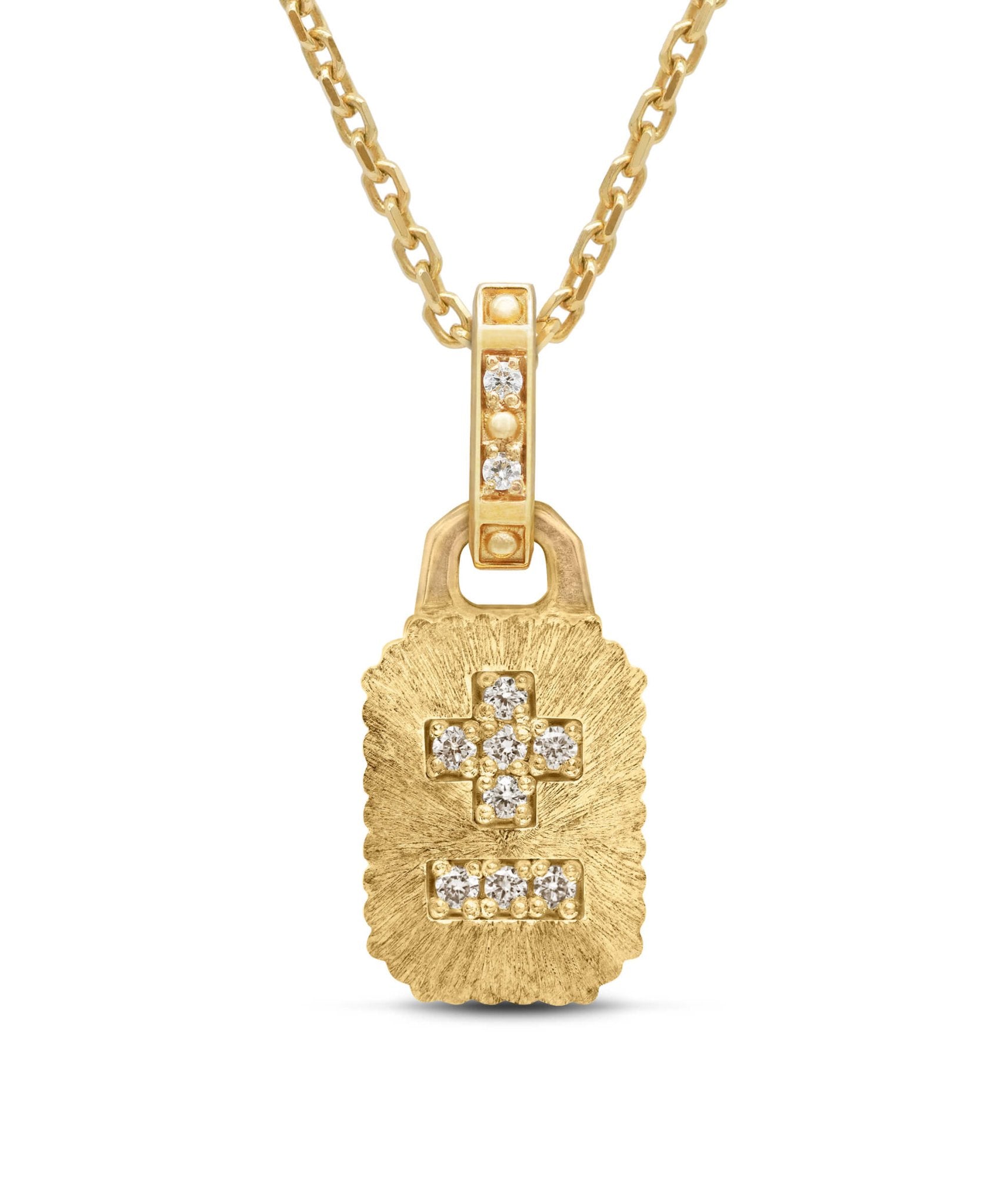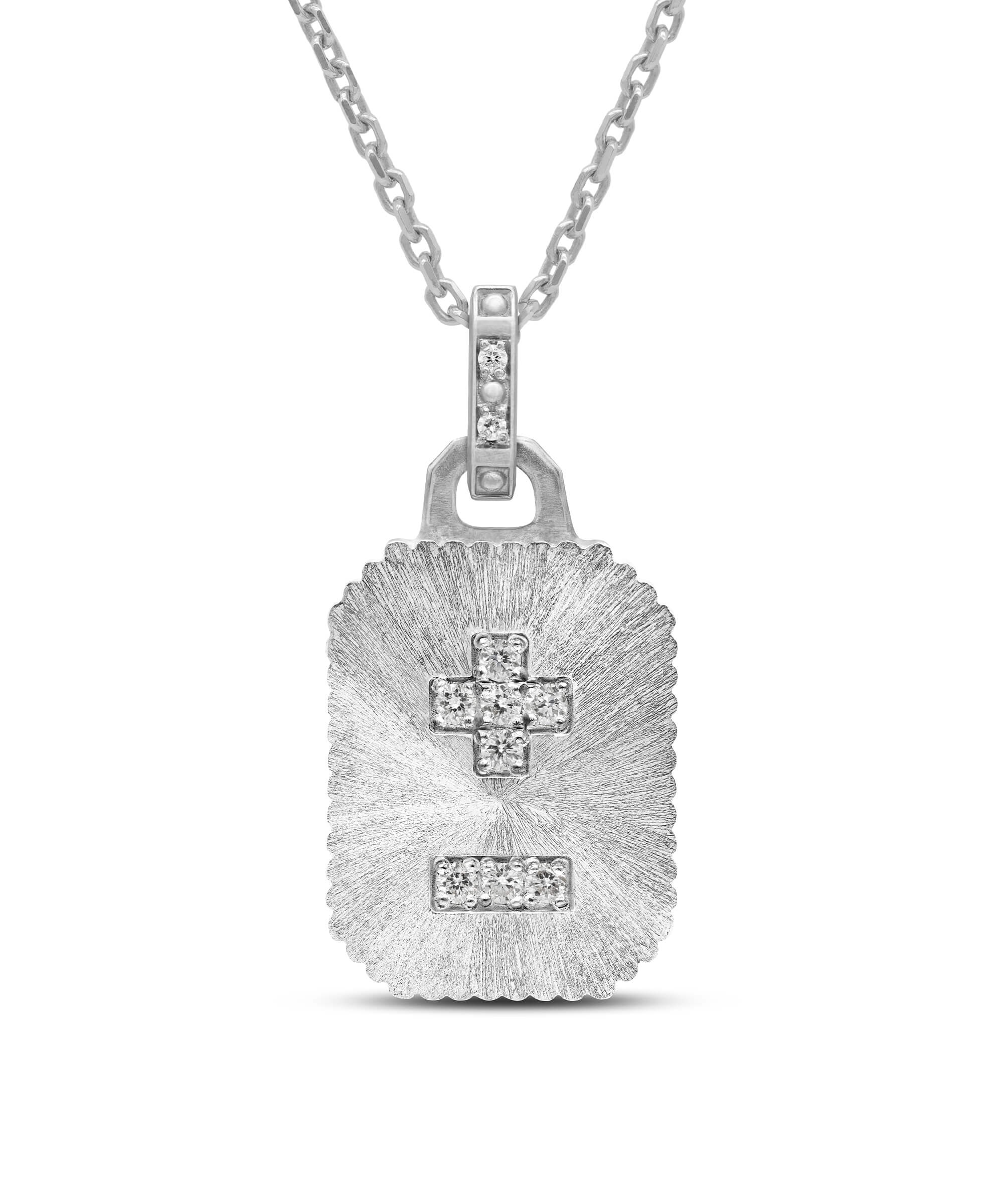The cross stands as one of the most universally recognized symbols, steeped in profound meaning and historical significance. From its role in ancient civilizations, where it symbolized life, balance, and intersection, to its evolution as a central emblem in Christianity, the cross has been a powerful and versatile symbol throughout the ages. Its presence extends beyond religious contexts, influencing art, architecture, literature, and contemporary jewelry. The cross's journey through various cultures and epochs reveals its enduring significance and multifaceted impact on human spirituality and cultural identity.
Amuletha™ Book of Symbols
Cross Symbol
Christ of Saint John of the Cross by Salvador Dalí
Salvador Dalí's "Christ of Saint John of the Cross" was inspired by a 16th-century sketch by Saint John of the Cross. It features a unique perspective of Christ from above, omitting traditional wounds to emphasize divinity. Initially controversial, it's now a renowned masterpiece, housed in Glasgow's Kelvingrove Art Gallery.
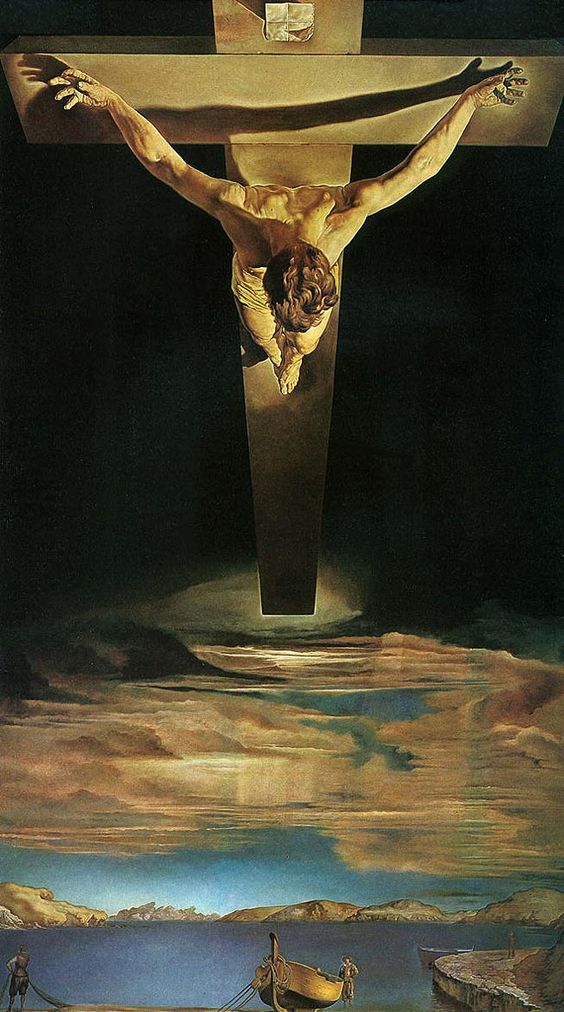
Christ of Saint John of the Cross by Salvador Dalí
Salvador Dalí's "Christ of Saint John of the Cross" was inspired by a 16th-century sketch by Saint John of the Cross. It features a unique perspective of Christ from above, omitting traditional wounds to emphasize divinity. Initially controversial, it's now a renowned masterpiece, housed in Glasgow's Kelvingrove Art Gallery.
CROSS SYMBOL ORIGIN
The cross, a symbol with profound historical roots, dates back to ancient civilizations long before its association with Christianity. Early uses of the cross symbol can be found in ancient Egypt, where the ankh, a cross with a loop at the top, represented eternal life and was often depicted in the hands of gods and pharaohs. This symbol spread through to other ancient cultures, such as the Assyrians and Babylonians, who used variations of the cross in their religious and cultural iconography.
In the Roman Empire, the cross was primarily seen as an instrument of execution. Crucifixion was a method used by the Romans to punish slaves, criminals, and political rebels, designed to serve as a public deterrent due to its harsh and humiliating nature. When Jesus of Nazareth was crucified in the 1st century AD, the cross began to take on a radically new meaning. For early Christians, Jesus' crucifixion and subsequent resurrection transformed the cross from a symbol of death and punishment into a profound emblem of sacrifice, redemption, and salvation. By enduring the crucifixion, Jesus imbued the cross with a spiritual significance that resonated deeply with his followers, marking it as the central symbol of Christian faith.
During the Middle Ages, the symbolism of the cross permeated various aspects of society. It was used in the design of churches and cathedrals, symbolizing the cruciform shape that represented Christ's sacrifice. Additionally, the cross was a prominent symbol in the Crusades, emblazoned on the tunics and shields of knights as a sign of their religious devotion. In modern times, the cross has transcended its religious origins to become a universal symbol of humanitarianism, featured in the emblem of the International Red Cross, representing aid and relief in times of crisis. This enduring symbol continues to evoke powerful spiritual and cultural resonances across the world.
What does cross symbolize
While the cross symbol carries numerous nuanced meanings, these four are the most universally recognized and embraced.
Faith
Universally recognized as a symbol of unwavering belief and spiritual devotion.
Redemption
Symbolizes the promise of salvation and forgiveness, central to Christian theology.
Sacrifice
Embodies the ultimate act of selflessness and love, epitomized by the crucifixion of Jesus.
Balance
Represents harmony and equilibrium between opposing forces, reflecting the cross's geometric symmetry.
Cultural mention
The cross, a symbol of profound significance, has left an indelible mark on various cultures and histories. Its presence extends beyond religious contexts, permeating legends, historical events, and artistic expressions. Compelling stories and cultural references involving the cross highlight its impact and the diverse ways it has been interpreted and revered throughout history. From ancient battles to architectural marvels, the cross continues to be a powerful emblem of faith, sacrifice, and inspiration across the world.
The Ankh Egypt’s Eternal Life Symbol
One of the most profound legends involving the Ankh, a cross-shaped symbol, revolves around the gods Isis and Osiris, central figures in ancient Egyptian mythology. Osiris, revered as the god of the afterlife and resurrection, was treacherously murdered by his jealous brother Set, who sought to usurp his throne. Set dismembered Osiris's body, scattering the pieces across Egypt. Overcome with grief but determined, Isis, Osiris’s devoted wife and a goddess of magic, embarked on a quest to find and reassemble his body. Using her powerful magical abilities, she successfully gathered the fragments and, with the divine assistance of the Ankh, which symbolizes life and immortality, she resurrected Osiris. This act of resurrection, often depicted in ancient Egyptian art with Isis holding the Ankh, highlights the symbol's profound connection to the themes of life conquering death and the cyclical nature of existence. The legend of Isis and Osiris, with the Ankh at its heart, underscores the belief in eternal life and the enduring power of love and devotion.
*Ankh mirror case from the Tomb of Tutankhamun, 1332-1323 BC.
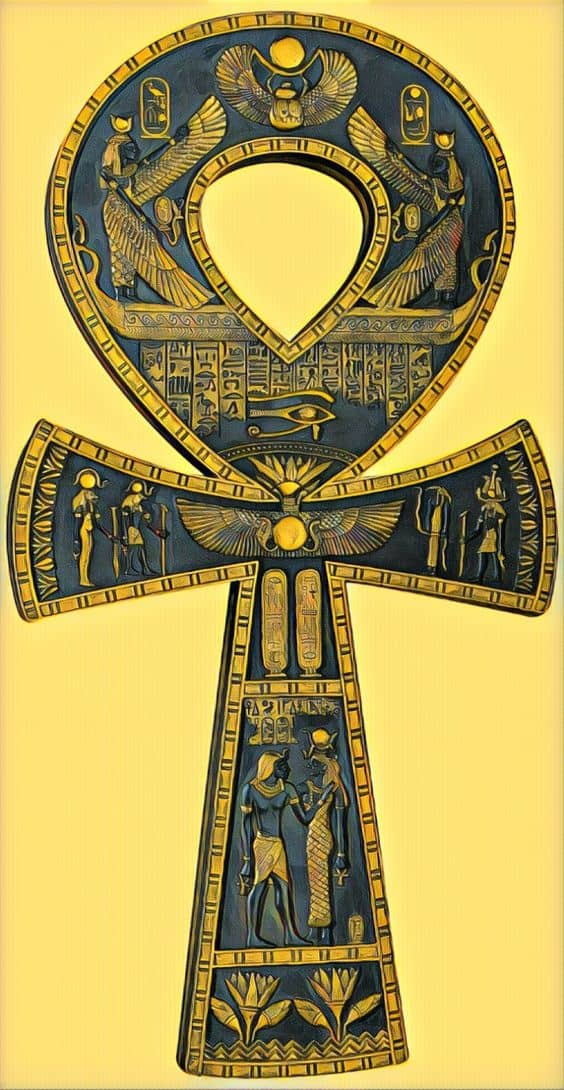
*Ankh mirror case from the Tomb of Tutankhamun, 1332-1323 BC.
Constantine's Vision of The Cross
One of the most famous stories involving the cross is the dramatic vision experienced by Emperor Constantine before the pivotal Battle of the Milvian Bridge in 312 AD. According to legend, on the eve of the battle, Constantine saw a radiant cross above the sun, accompanied by the words, "In this sign, conquer" (Latin: "In hoc signo vinces"). Interpreting this as a divine omen, Constantine, then a pagan, dreamt that Christ instructed him to use the cross in his battle standards. The next day, he ordered his soldiers to paint the symbol on their shields. Despite being outnumbered, Constantine’s troops, inspired by the vision, fought valiantly and secured a decisive victory against Maxentius. This triumph led to Constantine’s conversion to Christianity and the eventual adoption of the cross as a dominant symbol of the faith, marking a significant turning point in the history of Christianity and the Roman Empire.
Christ Appearing to Constantine, Paul Rubens
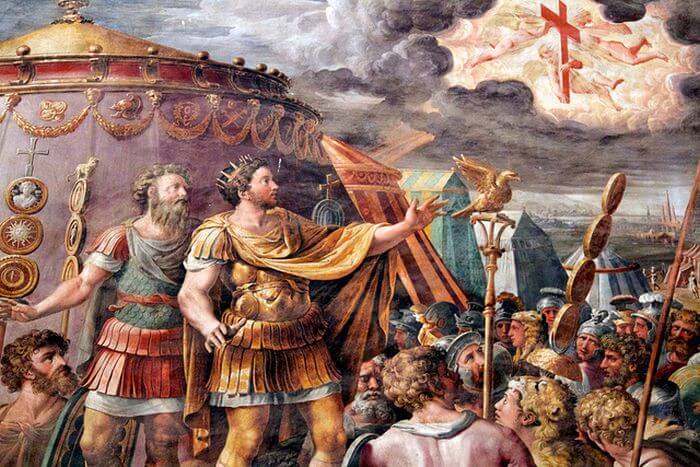
Christ Appearing to Constantine, Paul Rubens
The Cross in Gothic Architecture
The cruciform shape is fundamental to Gothic architecture, imbuing cathedrals with profound theological and aesthetic significance. Beginning in the 12th century, cathedrals such as Notre-Dame de Paris and Chartres Cathedral adopted the cross layout to symbolize Christ’s body, seamlessly integrating sacred geometry with religious narrative. These structures showcase medieval craftsmanship and the cross’s enduring symbolism, with their verticality drawing the gaze heavenward, embodying the aspiration towards the divine. Intricate stained glass windows, often illustrating the crucifixion, not only enhance the architectural beauty but also deepen the spiritual ambiance, transforming light into vivid, sacred storytelling.
Notre Dame cathedral from above
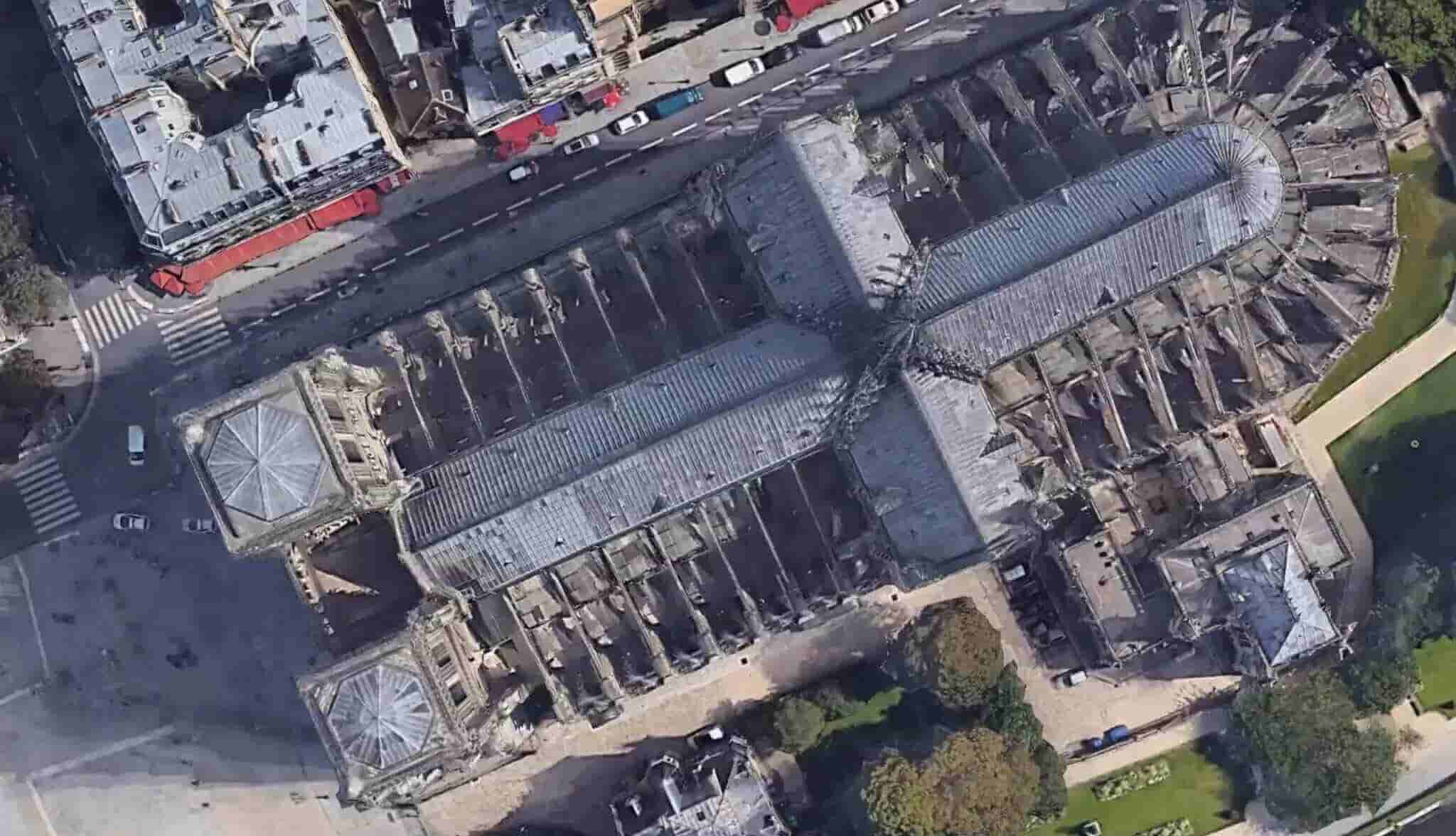
Notre Dame cathedral from above
Cross symbol in the world of jewelry
In the world of fine jewelry, the cross symbol epitomizes faith, protection, and timeless elegance, appealing to a diverse audience. Young adults are drawn to the cross for its representation of faith and personal growth, while older generations cherish its deep spiritual significance and historical resonance. The cross conveys protection, spiritual guidance, and unwavering faith, often treasured for its profound emotional and spiritual symbolism.Beyond its religious connotations, the cross also represents balance, intersection, and unity. In contemporary jewelry, it can symbolize the meeting of paths, personal transformation, and universal harmony. The simplicity and symmetry of the cross design make it a versatile piece that can embody various personal meanings, resonating with wearers regardless of their faith.Gifting cross jewelry transcends mere adornment, becoming a profound gesture of faith, devotion, or personal connection. Such a gift speaks volumes and is perfect for commemorating significant moments. A parent might bestow a cross pendant on their child as a symbol of guidance and protection, friends might exchange cross tokens to honor their bond, or a lover might present a cross necklace during a meaningful milestone. Each act is infused with deep sentimental value, reflecting both shared faith and personal significance.
CROSS SYMBOL IN LITERATURE
The cross, a symbol of faith, sacrifice, and redemption, has profoundly influenced literature across various genres, particularly in religious texts and medieval literature. Its potent symbolism adds layers of meaning to narratives, representing the struggle between good and evil, the burden of sacrifice, and the promise of salvation. Works like Dante’s "Divine Comedy" and the “The Cross" by George Herbert deeply explore the cross’s significance, showcasing its enduring impact on literary themes and character development, and revealing the profound depths of its symbolic power.
"The Divine Comedy" by Dante Alighieri
In Dante’s 14th-century epic, "The Divine Comedy", the cross appears as a symbol of divine justice and redemption. Throughout his journey in the "Inferno," "Purgatorio," and "Paradiso," Dante encounters various representations of the cross, reflecting his path towards spiritual enlightenment and salvation. The cross guides him through the realms of the afterlife, serving as a beacon of hope and a reminder of Christ’s sacrifice. Its presence underscores the theme of divine grace and the possibility of redemption for even the most lost souls.
Map of Hell by Botticelli
The "Map of Hell" painting by Botticelli is one of the surviving ninety-two drawings initially created for the illustrated manuscript of Dante's "Divine Comedy."
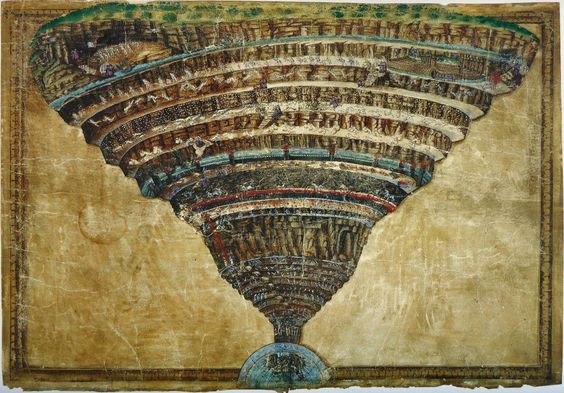
“The Cross" by George Herbert
What is this strange and uncouth thing?
To make me sigh, and seek, and faint, and die,
Until I had some place, where I might sing,
And serve thee; and not only I,
Herbert reflects on the paradox of the cross as both an instrument of suffering and a symbol of salvation. The poem delves into the dual nature of the cross, illustrating its profound impact on the Christian faith.
“The Ballad of the White Horse" by G.K. Chesterton
Our towns were shaken of tall kings
With scarlet beards like blood:
The world turned empty where they trod,
They took the kindly cross of God
And cut it up for wood.
Chesterton’s poem uses the cross as a symbol of Christian valor and faith. The poem recounts the exploits of King Alfred the Great, inspired by a vision of the cross to fight against pagan invaders.
“Easter" by George Herbert
Awake, my lute, and struggle for thy part
With all thy art.
The cross taught all wood to resound his name,
Who bore the same.
This poem reflects on the resurrection of Christ, using the cross as a central symbol of hope. Herbert explores themes of rebirth and redemption, illustrating how the cross, once a symbol of suffering, becomes a beacon of eternal life.
Thoughts
Thoughts placed alongside a symbol resonate with its meaning, serving as a guide to expand your understanding of the symbol's significance in relation to your personal experiences. AMULETHA™ also embraces this approach, invites a deeper contemplation of how symbolic meanings can reflect and enrich your life’s narrative, enhancing your appreciation of both the symbol and its broader implications.
An ethereal beacon - guiding souls with unwavering conviction and deep spiritual connection, illuminating the path to the divine.
A celestial promise - offering salvation and forgiveness, a divine embrace that restores and purifies the soul's essence.
A profound testament - the ultimate act of selfless love, immortalized in the sacred narrative of the crucifixion.
A mystical dance - where opposing forces find harmony, reflecting the cross’s perfect geometric symmetry and universal balance.
FREQUENTLY ASKED QUESTIONS
What non-religious meanings can the cross symbolize?
Beyond its religious significance, the cross can symbolize intersection, unity, and balance. It represents direction by indicating the four cardinal points and symbolizes life and death, marking the intersection of existence and mortality. The cross also signifies sacrifice, spiritual connection, protection, and healing, particularly in its association with health and medicine. Additionally, it represents identity, reflecting personal beliefs, values, and cultural heritage.
Did the cross symbol exist before Christianity?
Yes, the cross symbol predates Christianity. It was used in various ancient cultures, including Egyptian, where the ankh represented life, and in pre-Christian European and Asian societies, where cross-like symbols often signified the sun, life, and the cosmos.
Why do different types of crosses exist?
Different types of crosses exist because they reflect diverse cultural, historical, and religious contexts. Each variation has unique meanings and symbolism. For example, the Latin Cross represents the crucifixion of Jesus in Christianity, the Greek Cross with equal arms is common in Eastern Orthodox Christianity, and the Celtic Cross with a circle signifies eternity and unity. The Maltese Cross symbolizes chivalry and bravery, while the ankh in ancient Egypt represents life and immortality. These variations allow the cross to convey a wide range of spiritual, cultural, and symbolic messages.
Where is Jesus' crucifixion cross now?
The original cross on which Jesus was crucified, known as the True Cross, remains a subject of legend and historical mystery. According to Christian tradition, it was discovered by Saint Helena, the mother of Roman Emperor Constantine, during a 4th-century pilgrimage to Jerusalem. She reportedly identified the True Cross among three found at the crucifixion site through a miraculous healing. Fragments of the True Cross were then distributed as relics across the Christian world. Despite various claims by churches to possess pieces of the cross, the authenticity of these relics is debated, and no definitive evidence confirms the current whereabouts of the original cross.











